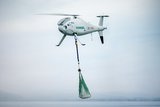Optical Bar camera sensor on RQ-4
Northrop Grumman has successfully flown an Optical Bar camera broad-area synoptic sensor on an RQ-4 Global Hawk high altitude long endurance (HALE) UAS, the company announced on 12 October.
The flight is the second of three planned demonstrations to fly legacy US Air Force sensors on board the Global Hawk. The first took place in February, when the UAS successfully flew with a SYERS-2 intelligence gathering sensor. For the next demonstration, the company plans to fly an MS-177 multi-spectral sensor later in 2016.
The high-altitude Optical Bar camera provides panoramic and unalterable imagery. The integration is possible due to Northrop Grumman's open mission systems architecture and universal payload adapter.
The payload is being integrated as part of proposals to boost the ISR capabilities of Global Hawk and prepare the UAS to take over the role of the manned U-2S Dragon Lady when it is retired from service at the end of this decade.
Mick Jaggers, vice president and program manager, Global Hawk program, Northrop Grumman, said: ‘The successful flight of the Optical Bar camera is another significant step in the evolution of Global Hawk. It’s the result of our focus on increasing capability, reducing sustainment costs and fielding the open mission systems architecture that enables faster integration of cutting edge sensors at lower costs.’
Related Equipment in Defence Insight
More from Uncrewed Vehicles
-
Jammer resistant drone designs spark search for countermeasures
The Russia-Ukraine conflict has driven another stage of evolution for drones and the counter measures to defend against them.
-
![L3Harris launches Amorphous software for control of uncrewed platforms]()
L3Harris launches Amorphous software for control of uncrewed platforms
The new Amorphous software is a universal controller that would allow a single operator to control a swarm of “thousands” of uncrewed systems, from drones to underwater platforms.
-
ideaForge unveils new UAVs at Aero India 2025
India UAV supplier ideaForge has launched the Netra 5 and Switch V2 drones at Aero India 2025, boasting of enhanced endurance, AI-driven autonomy and improved operational capabilities.
-
![Shaping the future of defence: What 2025 holds for the global drone market]()
Shaping the future of defence: What 2025 holds for the global drone market
The UAV market is experiencing unprecedented growth, with innovations in technology and battlefield applications driving demand across military sectors. From the battlefields of Ukraine to NATO exercises and beyond, drones are transforming how wars are fought and supported.
-
![Maris-Tech confirms customers signing up for Jupiter Drones codec and AI-powered system]()
Maris-Tech confirms customers signing up for Jupiter Drones codec and AI-powered system
Launched at AUSA in October, the company’s multi-stream video codec is attempting to bring a new lease of life to drone technology through its AI accelerator.
-
![AUSA 2024: Quantum-Systems targets big 2025 with UAS developments]()
AUSA 2024: Quantum-Systems targets big 2025 with UAS developments
Quantum-Systems has been upgrading its UAS family, with new versions of the Vector, Reliant and Twister drones set for release throughout 2025.
























